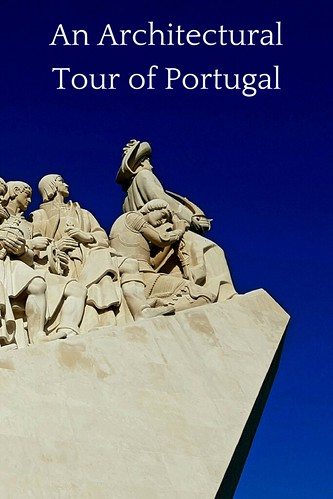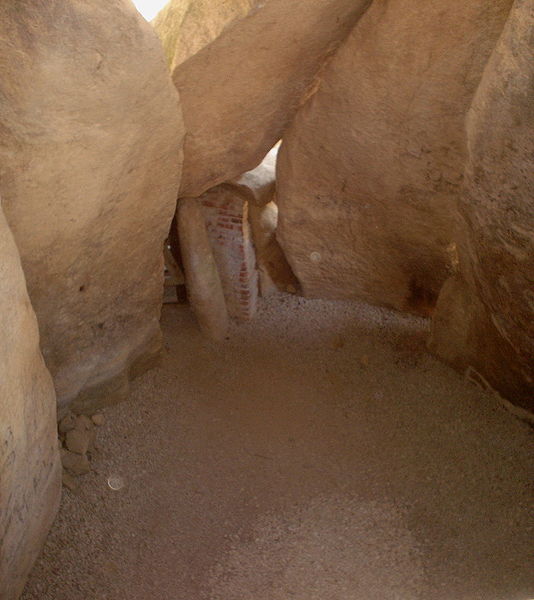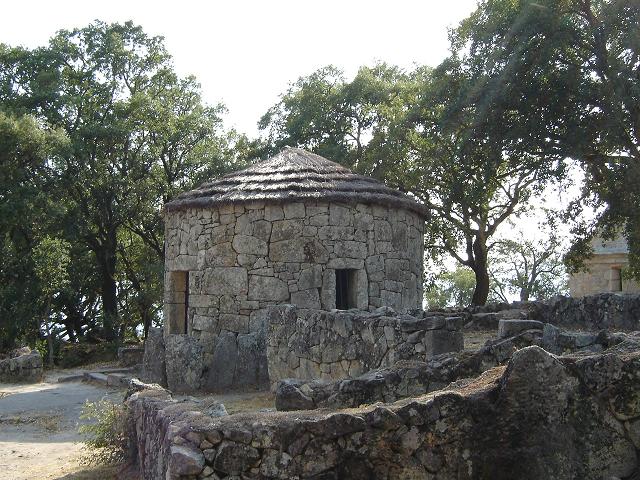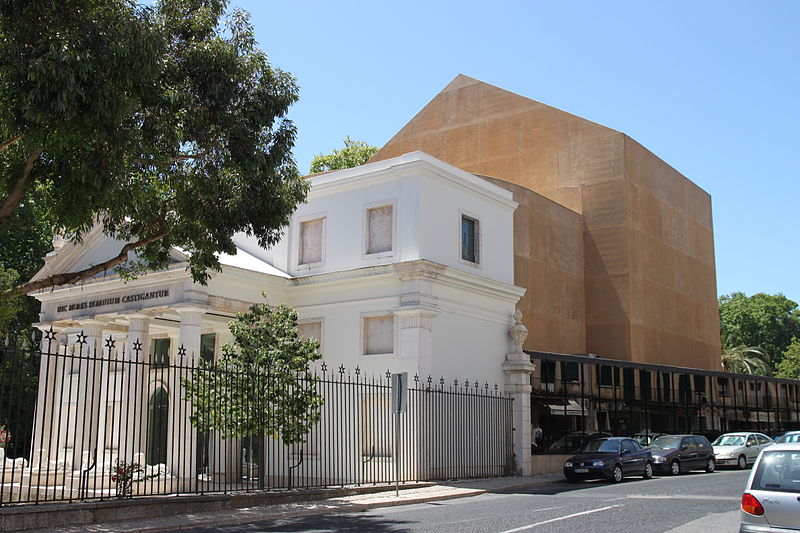Any visitor to Portugal will tell you that the architecture is a must-see. While you’re there, why not arrange your driving plans to include an architectural tour of Portugal?
An architectural driving tour of Portugal will teach you much about the history of the country, as well as draw you in with its beauty. There are 5 regions of Portugal to visit: Alentejo, Algarve, Centro, Lisbon, and Norte, although for the most part, the main areas to see are Lisbon and Oporto.
Portugal was founded as a country in the 12th century. But of course, there were many architectural styles before then.

Let’s discover Portugal’s architecture by time period…
Pre-Roman period
You can discover many examples of early architecture from the Neolithic era, including dolmens (also called antas), tumuli, standing stones, and menhirs. The best place to see these is in Évora. Be sure to see the Anta grande do Zambujeiro, which dates from 4000-30000BC.

Anta grande do Zambujeiro. Wikimedia Commons: João Correia
There are Celtic villages scattered throughout Portugal, dating from 2500-1700BC. My favorite is Citânia de Briteiros, the remains of a Castro settlement, located near Guimarães. It is an extremely well-preserved hill fort, complete with ruins of walls, ramparts, moats, family compounds, and a bath(!).

Citânia de Briteiros. Wikimedia Commons: JoaoMirandaBot
The Roman Period
The Romans arrived in the 2nd century BC, and, as they always did, modernized what they found. You can see remains of forums, those age-old Roman streets, temples, baths, bridges, and houses.
The most famous and best preserved remains of Roman architecture can be found at Conimbriga, near Coimbra (although if you are already in Évora, be sure to see the Roman Temple dedicated to Augustus). Conimbriga is a National Monument, and is a great stop on an architectural tour for both the ruins and the facilities (A museum! Restaurant! Gift shop!). You’ll see a great amount of houses, baths, walls, amphitheater, and forum.

Fish mosaic, Conimbriga. Wikimedia commons: Manuel Anastácio
Germanic Period
As we all know so well, the Romans were replaced by Germanic invaders, and then by the Moorish invaders. There aren’t many buildings left from this preRomanesque period, but you can see the Saint Frutuoso Chapel near Braga, which was built in the 7th century by the Visigoths, and is a National Monument.
Saint Frutuoso Chapel. Wikimedia Commons: Copyleft
Take time to see the Church of São Pedro de Lourosa, near Oliveira do Hospital – it was built in 912, as well as the Dolmen of Pinheiro dos Abraços, from the Neolithic period, also in Oliviera do Hospital.

Church of São Pedro de Lourosa. Wikimedia Commons: João Carvalho
Moorish Period
The Moors invaded Portugal in 711, and greatly influenced the design and architecture of the country, from the traditional housing colors and styles to the street layouts. There were many castles built, but most of them were updated in later periods. One of the Moorish castles that still shows the influence is Silves Castle, in Algarve. You can visit the ruins, as well as a visitor centre and botanical garden.
Entrance to Silves Castle. Wikimedia Commons: Lacobrigo
Mosques were built, of course, by the Moors, but few of them remain as such, having been repurposed for cathedrals. There is one building that still shows its beginnings, and is the best preserved medieval mosque in the country – the Main Church, located in Mertola, in the Alentejo.

The Main Church, in the foreground. Wikimedia Commons: zone41
The Romanesque Period
The Romanesque style (1100 – c. 1230) is a well-known architectural style from medieval Europe, and is noted for its arches, thick walls, and large towers. In Portugal, there are many to see and admire (and located throughout Portugal). These include:
- Braga Cathedral (1070s)
- Monastery of Rates (1096)
- Santa Cruz Monastery
- Oporto Cathedral
- Coimbra Cathedral (1162)
- Viseu Cathedral
- Lamego Cathedral
- Lisbon Cathedral (1147)
- Castle of Tomar
- Almourol Castle

Almourol Castle. Wikimedia Commons: Daniel Feliciano
The Gothic Period
Gothic architecture is also well-known, having been seen throughout Europe (c. 1200-c. 1450). It is well-known for flying buttresses, ribbed vaults, and pointed arches. A remarkable example of the early Gothic architecture is the Monastery of Alcobaça, in the Centro region, founded in 1153. It is a UNESCO World Heritage Site. Be sure to take time to view the carved tombs – they are extraordinary.

Monastery of Alcobaça, central aisle. Wikimedia Commons: syvwlch
Other important Gothic architectural buildings to see include:
- The Monastery of Batalha
- Parts of the St Francis Church of Évora
- Sintra Royal Palace
- Parts of cathedrals, including Guarda, Silves, Oporto, Lisbon, Coimbra, and more
- Parts of castles, including Beja, Estremoz, Braganca, Penedono, and Ourem
- Leira Castle
Late Gothic/Maneueline Period (c 1490 - c 1520)
Late Gothic architecture, called Manueline (after King Manuel 1), is a global mixture of Gothic, Renaissance, and Mediterranean influences. An excellent example of this is the Monastery of Jesus of Setubal (1490), a UNESCO World Heritage site. Also make time to see Lisbon's Jeronimos Monastery.

Nave of Jeronimos Monastery, Lisbon, Portugal. Wikimedia Commons: Sergio Calleja (Life is a trip)
Renaissance Period (c 1520-c 1650)
Renaissance architecture incorporated Greek and Roman designs and thought. This wasn’t fully embraced by the people of Portugal, but rather adapted into a style called Mannerism, which included Renaissance with the ideals of da Vinci, Raphael, and Michelangelo.
Sites to see include:
- The basilica of Nossa Senhora da Conceição in Tomar
- Claustro de D. João III (Cloister of John III) in the Convent of the Order of Christ in Tomar.
- The cathedrals of Leiria (1551–1574), Portalegre (begun 1556), and the Church of São Roque in Lisbon

Interior view of the Church of Sao Roque, Lisbon, Portugal
Restoration (a time of political upheaval and Portugal regaining independence)
& Baroque Periods (c 1640- c1755)
Baroque architecture was also not embraced by this region, but a few buildings were built in the tradition married to a new tradition, that of experimentation, including the Church of Santa Engrácia, in Lisbon.

Church of Santa Engrácia, now the National Pantheon. Wikimedia Commons: Alegna13
One of the best examples of Baroque architecture (albeit marries to Neoclassical architecture) is the Mafra National Palace, near Lisbon.

Mafra National Palace. Wikimedia Commons: Alvesgaspar
Other important architectural sites from this period include:
- Águas Livres aqueduc,t in Lisbon
- Palace of Necessidades, in Lisbon
- Queluz National Palace, in Lisbon
- Palácio do Raio, in Braga
Pombaline Period (1755-1860)
The Pombaline style is one that is unique to Portugal – here’s why! There was an enormous earthquake in Lisbon in 1755, which led to fires and a tsunami. Many of the buildings were utterly destroyed. The Prime Minister, the Marquis of Pombal, was charged with rebuilding the town. It can be seen in Lisbon, of course (including the Pombaline downtown and the Praça do Comércio), and is a style that is markedly utilitarian, with some Rococo detailing.
Rua Augusta in the Pombaline Baixa (Lower Town). Wikimedia Commons: OsvaldoGago
Arco da Rua Augusta, Lisbon, Portugal. Wikimedia Commons: OsvaldoGago
If you’re in the Algarve, head to the town Vila Real de Santo António, which was heavily influenced by this style.

Center of Vila Real de Santo Antonio. Wikimedia Commons: Dogpochi
The Modern Period
Architectural influences from Portugal’s Modern School, called School of Porto (now the School of Architecture at the University of Porto), can be seen worldwide. This is usually associated with alumni Fernando Távora, Álvaro Siza, Eduardo Souto de Moura, Tomás Taveira, Pancho Guedes, and Gonçalo Byrne. The modern style designed by these architects can be seen worldwide. Here are a few in Portugal:
Fundação Iberê Camargo. Ibere Camargo Foundation, Porto Alegre, designed by Álvaro Siza Vieira

Casa de Serralves, designed by architect José Marques da Silva.Wikimedia Commons: Rei-artur
Teatro Thália, an addition to a neoclassical (1843) theatre. Wikimedia Commons: João Carvalho
Torre São Gabriel, in the Parque das Nações (where expo 1998 took place). Wikimedia Commons: Paulo Juntas
Learn more about Portuguese Modern Architecture here.
Which is your favorite style of Portuguese architecture? What will you see first?
Note: this article was originally published in 2015 and updated in 2018





